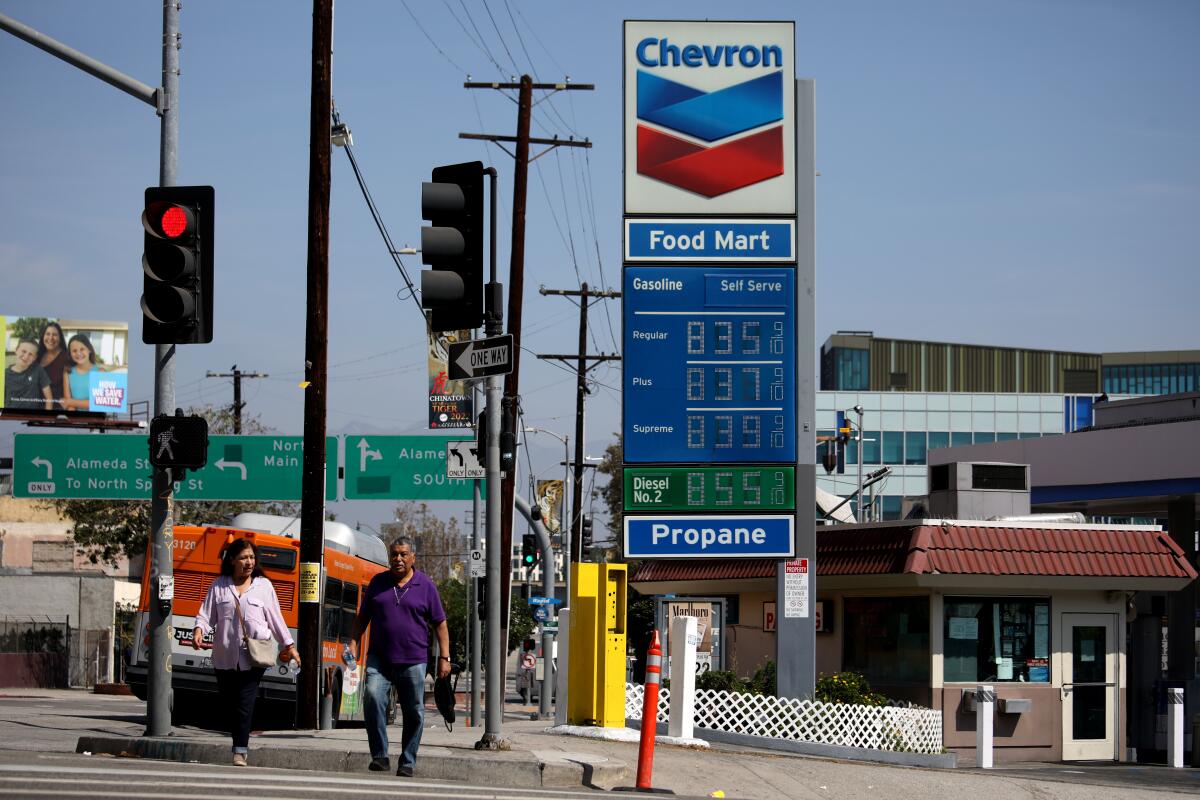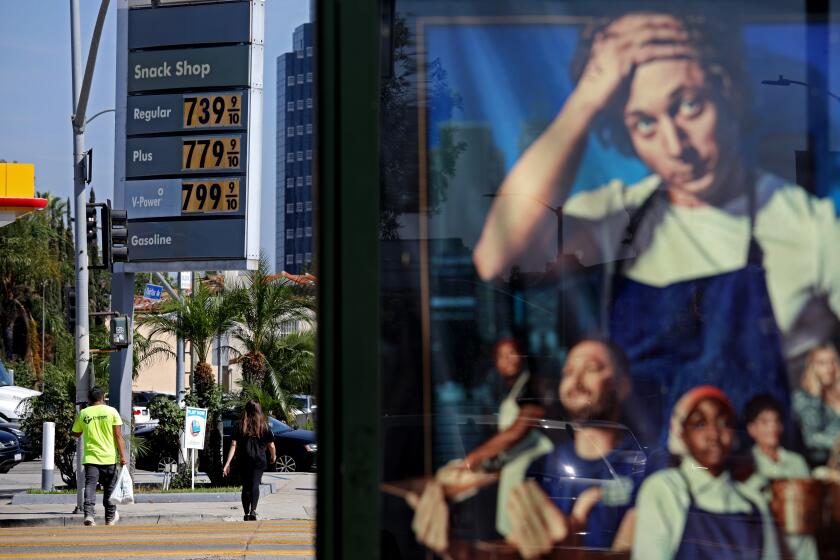Record gas prices, electricity woes show California’s worsening energy vulnerabilities

- Share via
California is getting another reminder of the volatility of its energy supply as shutdowns at several oil refineries have sent gas prices soaring, including to all-time highs Monday and Tuesday in Los Angeles.
At least five plants have recently faced maintenance-related stoppages or slowdowns, limiting supplies of California’s special blend of gasoline mandated to reduce pollution.
And unlike the nationwide spike in gasoline costs this summer — driven by high oil prices and a surge in travel — the recent rise in gasoline prices is unique to California and some of its Western neighbors, underscoring yet again the fragility of the state’s transitioning energy markets.
While Gov. Gavin Newsom responded last week to the drastic increases in fuel costs by jump-starting the state’s shift to its cheaper, winter-blend gasoline, energy experts say it could still be weeks until drivers get some real relief at the pump.
“We’re operating now in a ... tight market,” said Shon Hiatt, an associate professor of business at USC focused on the energy industry. “So if one refinery goes off to do maintenance, the prices are going to jump, because we don’t have much slack.”
California has seen the steepest gas price increase in the U.S. in the past week, up 59 cents to an average of $6.38 a gallon, according to AAA.
California has been moving rapidly to try to reduce dependence on gasoline vehicles, including a recent decision to ban the sale of new non-electric vehicles by 2035 and a proposal that would do the same to diesel big rigs by 2040.
It is all part of a larger effort by the state to be a leader in fighting climate change and transitioning to alternative fuels.
But for now, gas vehicles still dominate, and the state has a long way to go to strengthen its electric grid. This summer, a record-setting heat wave pushed the power grid to its limits, just narrowly avoiding rolling blackouts.
California now finds itself in an energy transition period.
As more and more oil refineries have gone offline in recent years — there are 14 now compared with almost 50 a few decades ago — California becomes precariously reliant on the few still operating, given the state’s more stringent gasoline requirements compared with the rest of the U.S., said Severin Borenstein, the director of UC Berkeley’s Energy Institute at the Haas School of Business.
“The reality is that as we phase out gasoline, we’re going to have fewer and fewer California refineries that make this blend,” Borenstein said. “And that’s going to make us more and more vulnerable to any one refinery, if they go out unexpectedly, to see a big price shock.”
Plenty of challenges lie ahead as California mandates zero-emission cars, including cost and access to charging.
Over the last week, California gas prices have seen the steepest uptick in the U.S., jumping 59 cents to an average of $6.38 a gallon Monday, according to data from the American Automobile Assn. Only Alaska came close behind, with a 54-cent increase during the same period, though other Western states have also seen noticeable increases.
The average gas price in Los Angeles broke records Monday and Tuesday, reaching a historic high of $6.47 Monday, only to be toppled at $6.49 Tuesday, according to AAA. Records were also set Tuesday across Southern California: in Orange County, the average gallon cost reached a new high of $6.45; in Ventura County, prices reached an average of $6.43; in San Diego County, $6.42; and in Riverside and San Bernardino counties, $6.36.
Gas prices started to creep upward in late September, after nearly 100 days of declines. Since then, prices have climbed consistently, with California drivers now paying on average $1.15 more for a gallon of regular gas than a month prior. A year ago, the average price for a gallon in California was below $4.50, about $2 below current prices.
California has consistently led the nation in gas prices in recent years, its premium price fueled by the state’s environmental laws and taxes on motor fuels, as well as the special blend of gasoline required during warmer months.
Oil refiners are required to follow specific gasoline formulas aimed at reducing air pollution when the temperature is high, to alleviate atmospheric smog. But those limitations also mean that when in-state gasoline production runs low or refineries choose to close, California is unable to rely on neighbors for additional supply.
“That’s a huge problem because we run such a tight supply-demand balance,” Borenstein said. “Obviously, we want to lose it eventually as we phase out gasoline. But losing it too early makes us really vulnerable to any sort of unpredicted supply-demand shock.”
It wasn’t immediately clear which refineries across the state faced short-term outages in recent weeks, either for planned or unplanned maintenance, but a statement from the California Energy Commission said that “refinery production issues” had been recorded in both Northern and Southern California. A spokesperson for Phillips 66 confirmed its refinery in the Los Angeles area was undergoing planned maintenance as of Monday.
Eleven of the state’s refineries produce transportation fuel that meets California’s gasoline standards, according to the CEC, providing gas for the entire state as well as most of Nevada and parts of Arizona. CEC officials said some of the recent refinery work that affected gasoline supply has been completed, but much remains ongoing and will not be complete until later this month.
Patrick De Haan, a petroleum analyst for GasBuddy, called the West Coast the “epicenter” of the recent gas price increases, which have driven up the national average, even as parts of the Gulf and East coasts have seen decreases in pump prices. With oil prices consistent of late, De Haan said the refinery issues are “front and center” to the market’s current changes.
He said at least five refineries in California have seen disruptions.
Record temperatures. Hot nights. Broiling beaches. Why this California heat wave was so extreme.
Hiatt said that most refineries in California did not take time for scheduled maintenance this spring, as the oil and gas industry boomed, which has worsened the timing of these outages. Without any oil pipelines that could bring in outside products and strict limits on how it can be imported, he called the state a “fuel island” and said he worries what could happen if even more refineries cease operations.
“We don’t have any resiliency,” Hiatt said. “I think we’re really at that delicate stage now where we have just about as much supply [as needed] to meet demand.”
Kara Greene, a spokesperson for the Western States Petroleum Assn., which lobbies for the oil and gas industry, said the state’s “inhospitable policies” toward oil and gas make it challenging to keep providing products that Californians need to commute and travel — and understandable when refineries do close down.
“These companies are not just producing the energy [Californians need], … they’re fighting for their license to operate,” Greene said.
Newsom, however, has placed the blame for rising costs in California at the feet of oil companies. He said in a video on Twitter on Friday that oil companies continue to ratchet up prices and “provide no explanation” as to why. The state’s Energy Commission also questioned oil industry executives about how supply levels have dropped so low, given that in previous years, refineries have prepared for such maintenance issues.
Newsom pointed out the stark difference in gas prices between California and the rest of the country. The national average for a gallon of regular stood at about $3.79, or $2.58 lower than California’s average.
Newsom calls on lawmakers to slap a windfall tax on oil companies.
“The degree of diversion from national prices have never happened before,” Newsom said in the video. “The fact is [oil companies] are ripping you off.”
Newsom’s decision to shift sooner to the state’s winter blend could increase supply by 5% to 10% in coming weeks, Borenstein said, but he didn’t expect to see large price dips immediately.
“I think we are going to see California prices level off in the next day or two,” Borenstein said. “But I don’t think we’re going to see huge declines for the next couple of weeks.”
Borenstein said he would like to see state officials adopt a more forward-thinking, long-term plan to prepare for unplanned fuel supply issues, as such situations will otherwise keep cycling.
“We need to take this seriously, instead of just being reactive when we get a price spike,” Borenstein said.
But unless that happens, Hiatt said consumers may have to get used to these spikes in pump payments — similar to how the risk of blackouts during extreme weather has become increasingly frequent. Officials have also proposed changes to state and federal law aimed at easing consumer gas costs, but it would be awhile before a new California tax or nationwide oil reserve could be implemented to provide financial relief — if either idea even makes it through the legislative process.
“I think in California, ... expect volatility,” Hiatt said. “The Legislature has put forward policy for the last 15 years focused entirely on reducing carbon emissions, to the neglect of reliability and prices, both in the liquid fuel — how they fuel cars — as well as electricity.”
Times staff writer Salvador Hernandez contributed to this report.
More to Read
Sign up for Essential California
The most important California stories and recommendations in your inbox every morning.
You may occasionally receive promotional content from the Los Angeles Times.















